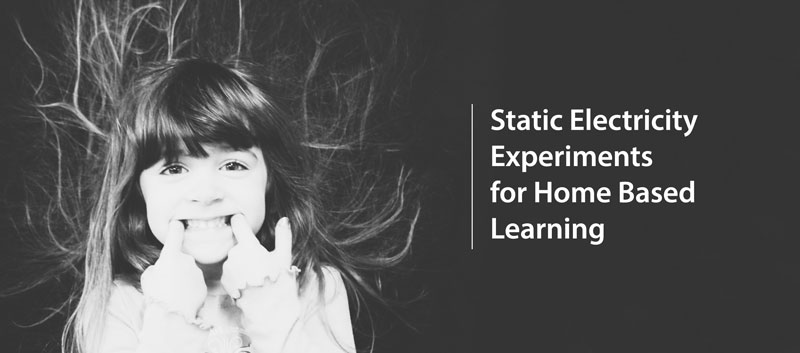Easy Static Electricity Experiments for Home Based Learning
Science experiments do not necessarily have to be practiced in a state-of-the-art chemistry, physics or biology lab in school. Science is all around us and its wonders can be discovered even at home.
What is Static Electricity
In K-12 schools across Dubai and other countries, the topic of ‘Static Electricity’ is introduced to students in Grade 4. So static electricity is the energy that can make your hair literally stand! It is a phenomenon where charged particles are transformed from one object to the other. You must have noticed that when two objects are rubbed against each other, in a dry surrounding, the objects acquire equal & opposite charges thereby developing a force between them. This is nothing but static electricity.
Some Facts About Static Electricity
- Static electricity builds up on the object’s surface with positive and negative ions which cancel out each other, thus making the static charge stay in one place.
- The two objects have different charges, one object would build-up positive charge and the other will have negative charge.
- Scientists discovered that lighting is a good example of static electricity. When ice particles within the cloud rub against each other, a spark or static force is generated, thereby causing a streak of lighting.
- Fabrics cling together due to static electricity when rubbed together. When the positive and negative ions come in contact, they attract each other and hence the materials cling.
- A photocopier machine that prints on paper uses the principles of static electricity. When the sheet is placed on the glass, an image is projected onto a positively charged drum and the drum conducts electricity when the light hits it. The toner on the other hand, has negative charge, so it gets attracted to the drum. This attraction between the toner and the drum, rolls out print on the blank piece of paper.
- In the future power banks wouldn’t be required to charge your phones. Research is being conducted to test whether phones bouncing in one’s trouser pockets is sufficient to recharge the batteries of the device. How cool is that!
Fun with Static, Try these Simple Experiments at Home
Floating Plastic Bag
Take a plastic rod and rub it against a piece of cloth for about 50 seconds. Lay the plastic bag on a table and now repeat step 1 by rubbing the piece of cloth, but this time onto the surface of the plastic bag. Move the charged plastic rod over the plastic bag and watch the charged plastic bag fly as if there were no gravity on Earth! Astonishing isn’t it?
Explanation: When you rubbed the plastic rod to the cloth, the rod got negatively charged and the same happened to the plastic bag when it was rubbed against the cloth. Now the rod and the plastic bag have negative energies and when they come close to each other, they seem to repel or move apart – as same energies seem to repel against each other.
Changing the Course of the Water Stream
Take an inflated balloon and rub it against your hair for a couple of seconds. Turn on the faucet of water attached to a sink and bring the rubbed balloon close to the steady stream of water flowing. Remember, do not touch the balloon to the water, just bring it really close. You would be amazed to see that water gets attracted and moves towards the balloon magically.
Explanation: When the balloon was rubbed on the head, it got charged with negative ions. Water naturally has a composition as H2O (two molecules of Hydrogen and one molecule of oxygen). Since more of hydrogen is present it water, it is slightly positively charged. When the positive stream of water is introduced to the negatively charged balloon, they being opposite forces attract to each other. Hence the water appears to move towards the balloon.
Separating Salt and Pepper from the Mixture
Did you know separating salt and pepper seasoning is possible with a simple static experiment! Take a bowl and mix a teaspoon of salt and pepper powder thoroughly. Rub the spoon over a cloth for 50 seconds. Bring the spoon over the salt & pepper mixture and watch the pepper jumping towards the spoon.
Explanation: When the spoon is rubbed it gets negatively charged. Both salt and pepper granules have positive energy. The negatively charged spoon when brought close to the mixture attracts the positive ions of the pepper & salt, but only the pepper jumps towards the spoon as it is slightly lighter than salt and sticks to the base of the spoon. So next time your toddler mischievously mixes salt and pepper, don’t be mad at him. Simply work through the experiment and get them separated!
If you are a working parent and don’t have time to arrange for materials required to carry out the experiments, we present to you Carolina’s Science Kits. Carolina is amongst the largest provider of Science kits to schools across all areas of physics, chemistry, and biology. In-fact most IB Schools in UAE and GCC Countries rely on Carolina to stock their science labs with dedicated pre-categories ‘science kits’ for children.
Carolina’s Triboelectric Series Kit emphasis on introducing children to Static Electricity by supplying readymade materials to carefully undertake the experiment. The kit comprises of different textures like; silk, wood, Teflon, cotton, wool, nylon, etc. so that students thoroughly understand the concept. For more details about purchasing the Carolina Kits in the Middle East, visit our website: https://knowledge-hub.com/






Recent Comments